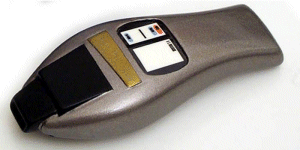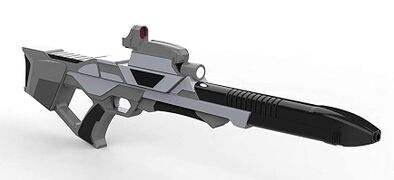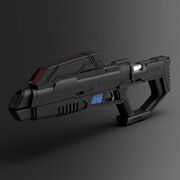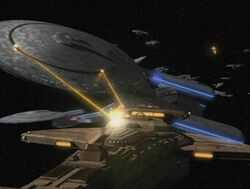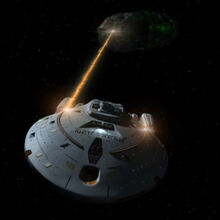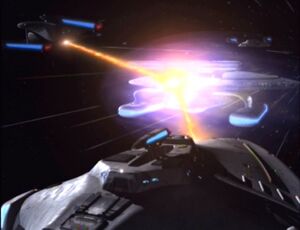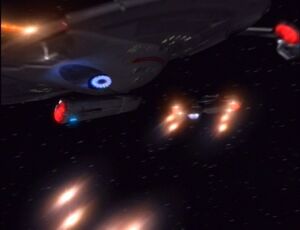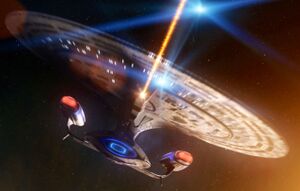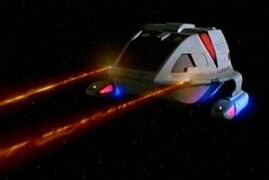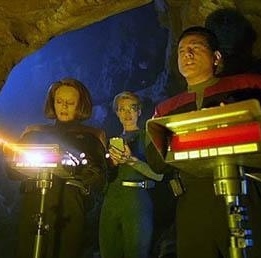Difference between revisions of "Phasers"
CrimsonTacit (talk | contribs) |
Teylasramar (talk | contribs) |
||
| (14 intermediate revisions by 3 users not shown) | |||
| Line 1: | Line 1: | ||
{{ | {{icons|bfc|tech}}'''Phasers''' are the most common energy weapon in use by a number of powers in the Alpha and Beta Quadrants, including the Federation, Cardassians, and Bajorans. Originally an acronym meaning “PHASed Energy Rectification,” phasers operate by the application of the so-called “rapid nadion effect (RNE),” using nadions to amplify the effect of superconducting crystals to create a coherent and highly-controllable beam of energy to create effects ranging from heating targets to causing targets to lose molecular cohesion entirely. | ||
== | ==Overview== | ||
[[File:PhaserOutputChart.PNG|right|frameless]] | [[File:PhaserOutputChart.PNG|right|frameless]] | ||
Phasers are classified both by their type rating (which is their theoretical maximum energy output) and their form factor (which is the type of device or implement they are constructed as). Their actual output is dependent on the power available to them; for instance, the benefit of employing a higher type of array than a vessel could comfortably use at full power is to increase reliability and fleet standardization. The increase in power between various phaser types is not equal across the scale due to the idiosyncratic properties of nadion fields, which makes some types uneconomical to use. | Phasers are classified both by their type rating (which is their theoretical maximum energy output) and their form factor (which is the type of device or implement they are constructed as). Their actual output is dependent on the power available to them; for instance, the benefit of employing a higher type of array than a vessel could comfortably use at full power is to increase reliability and fleet standardization. The increase in power between various phaser types is not equal across the scale due to the idiosyncratic properties of nadion fields, which makes some types uneconomical to use. | ||
| Line 7: | Line 7: | ||
The maximum output for each phaser type is the theoretical limit at which the nadion field would collapse and the phaser would begin to damage itself, but the maximum output is dependent on a sufficient power supply. That is to say that a Type-X phaser on an [[Intrepid Class|''Intrepid''-class light explorer]] will be substantially less powerful than one on a [[Galaxy Class|''Galaxy''-class explorer]] because of the difference in their power plants. | The maximum output for each phaser type is the theoretical limit at which the nadion field would collapse and the phaser would begin to damage itself, but the maximum output is dependent on a sufficient power supply. That is to say that a Type-X phaser on an [[Intrepid Class|''Intrepid''-class light explorer]] will be substantially less powerful than one on a [[Galaxy Class|''Galaxy''-class explorer]] because of the difference in their power plants. | ||
While there are numerous types and form factors, phasers can be broken down into two larger styles: standard phasers use a single emitter crystal at the point where the energy leaves the device to focus the beam, while compression phasers use a barrel with either optronic or physical amplification (or a combination of both) to produce a more concentrated beam or pulse. Theoretically, most output classifications could be built in any form factor (i.e. one could build a Type-XV phaser rifle if one had a strong enough power source, or a Type-I phaser array if one had a use for it), though Starfleet typically uses just a few combinations of form factor and output types | While there are numerous types and form factors, phasers can be broken down into two larger styles: standard phasers use a single emitter crystal at the point where the energy leaves the device to focus the beam, while compression phasers use a barrel with either optronic or physical amplification (or a combination of both) to produce a more concentrated beam or pulse. Theoretically, most output classifications could be built in any form factor (i.e. one could build a Type-XV phaser rifle if one had a strong enough power source, or a Type-I phaser array if one had a use for it), though Starfleet typically uses just a few combinations of form factor and output types. | ||
== | == Starfleet Phasers == | ||
Starfleet has long preferred the phaser as its energy weapon of choice because of its versatility and reliability. Indeed, Starfleet vessels and personnel use their phasers for scientific, engineering, and navigation tasks much more often than they use them in anger, as phasers can do everything from heat up rocks to provide survival warmth to deep drilling to space debris removal. While Starfleet has an incredibly diverse fleet, most phasers in service fit into one of several standard configurations. This is not an inclusive list of every design, though, as some ship classes have equipment unique to their role, such as the Type-XIV phaser cannons aboard the ''[[Gagarin Class|Gagarin]]'' or the phaser turrett found on the ''[[Odyssey Class|Odyssey]]''. | |||
===Type-I & II Hand Phasers=== | === Standard-Issue Personal Phasers === | ||
Starfleet issues a small variety of sidearms to its personnel for both personal defense and utility purposes. They are easy to operate, with significant auto-targeting functions provided by their onboard computers that both help correct for aim and have largely eliminated the need for bulky sites in most applications. Personal phasers can produce beams or bolts of energy, depending on the tactical or utilitarian requirements of the situation. | |||
In addition to standard phasers, Starfleet has developed compression phasers, which have additional focusing coils (and thus a more identifiable barrel) which allow them to compress a beam of energy more tightly or store it briefly to release as a bolt, which is generally more damaging than a standard beam but potentially less accurate. Compression phasers are noted to operate in areas with interference that would disable other phaser types. | |||
====Overview of Standard Operations==== | |||
*All Starfleet personnel are issued a type-I phaser. Until they are fully trained in its use, they receive a variant which is hardware locked to a maximum of setting three: heavy stun. | |||
*Type-II phasers are worn by security personnel while performing specific duties, such as guarding a secure location, and at yellow and red alerts. They are also standard equipment for most away teams and can be distributed to other crewmembers at the captain or station commander's instructions. | |||
*Type-III phasers are only issued when a serious tactical threat is anticipated, and they are not standard away team equipment. | |||
*Active duty personnel are expected to maintain phaser proficiency with safety reviews occurring every three months. | |||
*No phaser can be fired on a starship or in a Starfleet facility without being detected, as each phaser contains a subspace transceiver that links to the starship or station computer. This transceiver also allows the commanding officer to set a maximum setting. The default maximum setting is heavy stun. | |||
====Type-I & II Hand Phasers==== | |||
Hand phasers are the most common types of phasers issued to Starfleet personnel, aboard ships and starbases, and for planetside duty. They are versatile, easy to operate, and highly portable, with most humanoids being able to operate them with just one hand. Starfleet hand phasers come in type-I and type-II versions, with the type-II version being the standard side-arm for nearly every situation; the type-I is generally only used when discretion about being armed is desired. Modern hand phasers can emit either bolts or coherent beams of energy, depending on the needs of the mission. Their settings range from Level 1 (Light Stun) to Level 10 (Kill) to Level 16 (Vaporize). | Hand phasers are the most common types of phasers issued to Starfleet personnel, aboard ships and starbases, and for planetside duty. They are versatile, easy to operate, and highly portable, with most humanoids being able to operate them with just one hand. Starfleet hand phasers come in type-I and type-II versions, with the type-II version being the standard side-arm for nearly every situation; the type-I is generally only used when discretion about being armed is desired. Modern hand phasers can emit either bolts or coherent beams of energy, depending on the needs of the mission. Their settings range from Level 1 (Light Stun) to Level 10 (Kill) to Level 16 (Vaporize). | ||
Early hand phasers closely resembled earlier types of weapons such as projectile-firing pistols, but by the 2350s, phasers were generally shaped less-obviously like a weapon and consisted of a long handle that curved down to the emitter point. The firing trigger is on the top of the device. By 2385, pistol-style hand phasers have been reintroduced to Starfleet, and both types continue to be produced. | Early hand phasers closely resembled earlier types of weapons such as projectile-firing pistols, but by the 2350s, phasers were generally shaped less-obviously like a weapon and consisted of a long handle that curved down to the emitter point. The firing trigger is on the top of the device. By 2385, pistol-style hand phasers have been reintroduced to Starfleet, and both types continue to be produced. | ||
These are the | These are the four most common models of hand phaser in service with Starfleet as of the 25th century: the Type-I and Type-II models introduced in the late 2370s that continue to be common across the fleet, and the newer 2380s-era Type-I compression phaser and Type-II compression phaser pistol: | ||
<gallery> | <gallery mode="packed"> | ||
File:FirstContactType1.gif| | File:FirstContactType1.gif|2375-style Type-I hand phaser | ||
File:PhaserNemesis.jpg | File:PhaserNemesis.jpg|2379-style Type-II hand phaser | ||
File:PicardType2.jpg | </gallery> | ||
<gallery mode="packed"> | |||
File:Type1Prodigy.jpg|2383-style Type-I compression phaser | |||
File:PicardType2.jpg|2385-style Type-II compression phaser pistol | |||
</gallery> | </gallery> | ||
| Line 28: | Line 45: | ||
*While the Type-I phaser was common in TOS and in early episodes of TNG, it hasn't been seen in recent iterations of ''Star Trek''. That doesn't mean your character wouldn't have a use for one of these smaller devices; they might be carried concealed by security officers during diplomatic missions, or be stashed in a medical kit by a doctor who expects trouble on an away mission. | *While the Type-I phaser was common in TOS and in early episodes of TNG, it hasn't been seen in recent iterations of ''Star Trek''. That doesn't mean your character wouldn't have a use for one of these smaller devices; they might be carried concealed by security officers during diplomatic missions, or be stashed in a medical kit by a doctor who expects trouble on an away mission. | ||
*Hand phasers and phaser rifles vary from assignment to assignment; starships sticking close to home and minor bases are unlikely to have the best and newest equipment, and some ships will have bespoke designs based on the needs of their mission and the physiology of their crew, but all Starfleet phaser types share basic design features such as a very simple firing mechanism, adjustable power levels, and assisted targeting. | *Hand phasers and phaser rifles vary from assignment to assignment; starships sticking close to home and minor bases are unlikely to have the best and newest equipment, and some ships will have bespoke designs based on the needs of their mission and the physiology of their crew, but all Starfleet phaser types share basic design features such as a very simple firing mechanism, adjustable power levels, and assisted targeting. | ||
*Phasers have been a feature of ''Star Trek'' (other than the original pilot) since the beginning of the franchise. The hallmark of this iconic energy weapon is the ability for the user to select the power being used: it can do everything from heat rocks for warmth to stun an enemy to vaporizing large amounts of matter. | * Phasers have been a feature of ''Star Trek'' (other than the original pilot) since the beginning of the franchise. The hallmark of this iconic energy weapon is the ability for the user to select the power being used: it can do everything from heat rocks for warmth to stun an enemy to vaporizing large amounts of matter. | ||
===Type-III Phaser Rifle=== | ==== Type-III Phaser Rifle==== | ||
Phaser rifles are larger than hand phasers and are generally the heaviest personal weapons stocked aboard most Federation starships. While they have the same sixteen settings as their smaller counterparts, their power cells allow them to fire more quickly, for longer periods of time, and at longer range, which makes them well-suited to extended firefights. Generally speaking, | Phaser rifles are larger than hand phasers and are generally the heaviest personal weapons stocked aboard most Federation starships. While they have the same sixteen settings as their smaller counterparts, their power cells allow them to fire more quickly, for longer periods of time, and at longer range, which makes them well-suited to extended firefights. Generally speaking, a phaser rifle can fire twice as many shots twice as far as a hand phaser, in either bursts or coherent beams. They are only commonly used when combat is anticipated, and are not standard away team equipment. | ||
These are the two most common phaser rifles in Starfleet service, both of which are compression rifles: a model introduced in the late 2370s and a ruggedized version developed in the late 2380s: | These are the two most common phaser rifles in Starfleet service, both of which are compression rifles: a model introduced in the late 2370s and a ruggedized version developed in the late 2380s: | ||
<gallery> | <gallery mode="packed"> | ||
File:PhaserRifleNemesis.jpg | File:PhaserRifleNemesis.jpg|A standard Type-3 phaser rifle. | ||
File:PicardType3.jpg | File:PicardType3.jpg|A ruggedized Type-3 phaser rifle. | ||
</gallery> | </gallery> | ||
| Line 44: | Line 61: | ||
*Phaser rifles wouldn't be stocked at all on civilian ships or medical ships. | *Phaser rifles wouldn't be stocked at all on civilian ships or medical ships. | ||
== Starship Phaser Arrays == | ===Starship Phaser Arrays=== | ||
[[File:GalaxyType10.jpg|thumb|250x250px|A ''Galaxy''-class starship firing two beams from its main phaser array.]]Phaser Banks were once the standard shipboard energy weapon in use by Starfleet, but have now been nearly entirely supplanted by phaser arrays, except on extremely old vessels and on small craft. They consist of a single phaser emitter segment that fires in a fixed direction, with aiming provided either mechanically or using magnetic fields. | [[File:GalaxyType10.jpg|thumb|250x250px|A ''Galaxy''-class starship firing two beams from its main phaser array.]]Phaser Banks were once the standard shipboard energy weapon in use by Starfleet, but have now been nearly entirely supplanted by phaser arrays, except on extremely old vessels and on small craft. They consist of a single phaser emitter segment that fires in a fixed direction, with aiming provided either mechanically or using magnetic fields. | ||
Phaser Arrays are the current standard shipboard energy weapon in use by Starfleet, consisting of dozens or hundreds of interlocking emitter segments that combine multiple superconductive crystals to form a much more powerful beam than a single emitter segment could alone. Phaser arrays use magnetic fields to guide energy in certain directions for targeting purposes and have | Phaser Arrays are the current standard shipboard energy weapon in use by Starfleet, consisting of dozens or hundreds of interlocking emitter segments that combine multiple superconductive crystals to form a much more powerful beam than a single emitter segment could alone. Phaser arrays use magnetic fields to guide energy in certain directions for targeting purposes and have few moving parts. Phaser arrays have a visible build-up as a firing sequence is charged, with energy coming from two sides and meeting at the firing point. Arrays can fire multiple beams at the same time, as well. | ||
===Type-X Phaser Array=== | ====Type-X Phaser Array ==== | ||
[[File:IntrepidTypeX.jpg|thumb|A type-X phaser array being fired by the starship ''Voyager.'']] | |||
The Type-X phaser array was developed for the ''Galaxy''-class explorer and remains the standard phaser design in use for the majority of Starfleet's modern starships, especially those that are not regularly assigned to defensive missions. This type of array is powerful enough to go toe-to-toe with any Alpha or Beta quadrant power's vessels, though most starships equipped with them do not have the power to use them at their full 5.1 MW potential. This type was fitted to the vast majority of designs created in the later part of the 2360s and early 2370s, and most vessels originally equipped with Type-IX arrays still in service have been upgraded to this new standard. | |||
'''In-Play''' | |||
The Type-XII phaser array first debuted in space aboard the ''Sovereign''-class explorer and is the | *The Type-X phaser was the main starship-based phaser we saw in both ''Star Trek: The Next Generation'' and ''Star Trek: Voyager'', which are set 35 and 28 years respectively before our canon. They're still capable and powerful weapons, but they've been out-classed by the Type-XII. These arrays are still on service on many smaller designs, as well as science vessels, utility vessels, and other ships not intended for heavy combat. | ||
*Starship-based phasers have similar qualities to their smaller cousins; the reason Starfleet favors this weapon is for its versatility, not its brute force. They can also be used for scientific and engineering purposes, just like smaller models. | |||
====Type-XII Phaser Array==== | |||
[[File:PrometheusTypeXII.jpg|thumb|Two sections of a ''Prometheus''-class starship firing their type-XII phaser arrays.]] | |||
The Type-XII phaser array first debuted in space aboard the ''Sovereign''-class explorer and is still the standard for most multi-role starships as of 2401. Originally known by its classified designation as the Type-X+, this system was originally used for large-scale planetary defense systems, but miniaturization and advancements in superconductor technology allowed it to be used on starships. Though this standard is over twenty years old, Starfleet has settled on the Type-XII as an excellent all-around combination of power, size, and reliability for starship phasers. | |||
'''In-Play''' | |||
* | * | ||
* Any starship designed after | *Any starship designed after the Dominion War that wasn't specifically meant to be a utility ship or other light-duty vessel will generally have Type-XII phaser arrays. Like with the Type-X, smaller ships can't use them at the same power levels as larger vessels with larger power plants. | ||
==== Type-XIV Phaser Array ==== | |||
The Type-XIV phaser array standard was developed alongside the ''Sagan''-class light explorer, and uses innovations derived from Borg technology to enhance resilience and accuracy. These arrays are capable of 150% percent of the raw firepower of Type-XII arrays without significantly increased maintenance or footprint, but their construction techniques require a large amount of components which can't be created through replication, which will make their wide-spread deployment slow. Still, Starfleet is considering refits to its larger capital ships with this new standard. | |||
'''In-Play''' | |||
* These are the newest of new phasers, found on a limited number of classes. | |||
===Starship Phaser Cannons=== | |||
===== Type-XV Phaser Cannon ==== | ====Type-XII Pulse Phaser Cannon==== | ||
[[File:PulsePhaserCannon2.jpg|thumb|A set of pulse phaser cannons being fired by a ''Defiant''-class ship.]] | |||
Pulse Phaser Cannons use a large, finely-tuned spherical focusing crystal as well as a magnetic focusing barrel to create powerful bursts of energy, being able to deliver massive amounts of fire-power in a single direction. Type-XII cannons are only employed on a handful of starship designs, and all of these designs are meant for combat. They require being mounted on a fast, maneuverable ship, because they lack the wide arcs of coverage that phaser arrays provide. They were first employed on the USS ''Defiant'', designed as an anti-Borg weapon. | |||
'''In-Play''' | |||
*Only a handful of classes use phaser cannons, because they're much less versatile than phaser arrays. They require the vessel to be pointed pretty precisely at its intended target, as they have limited aiming capabilities out of their narrow arc. Because of this, vessels that use them must rely on their maneuverability and speed to keep a target in their sights. | |||
*Some vessels (as noted in their write-ups) have mounts for these cannons but do not regularly carry them, which is meant as an easy way of upgrading them for war-time situations. | |||
====Type-XV Phaser Cannon==== | |||
[[File:TypeXVPhaserCannon.jpg|thumb|A spinal phaser cannon aboard the USS ''Federation'' in testing.]] | |||
The Type-XV phaser cannon, sometimes referred to colloquially as a "phaser lance" because of its spinal mount, is a unique weapon designed exclusively for the twelve so-called [[Galaxy Refit Class|''Dreadnought''-class]] starships based on the ''Galaxy'' spaceframe. Intended as a "Borg Buster," this weapon can deliver an extremely high amount of energy in a fixed direction, meant to overwhelm a Borg vessel's defenses before it can adapt. This is the most powerful weapon ever mounted on a Starfleet vessel, and in practice, it can cause significant damage to most known threat vessels. | The Type-XV phaser cannon, sometimes referred to colloquially as a "phaser lance" because of its spinal mount, is a unique weapon designed exclusively for the twelve so-called [[Galaxy Refit Class|''Dreadnought''-class]] starships based on the ''Galaxy'' spaceframe. Intended as a "Borg Buster," this weapon can deliver an extremely high amount of energy in a fixed direction, meant to overwhelm a Borg vessel's defenses before it can adapt. This is the most powerful weapon ever mounted on a Starfleet vessel, and in practice, it can cause significant damage to most known threat vessels. | ||
'''In-Play''' | |||
*No member-available starship has a Type-XV phaser cannon; they're exclusively found on the ''Galaxy''-class Refit, aka the ''Dreadnought''-class. You might encounter one in a campaign or other type of event, but all of these vessels are normally held in mothballs. | |||
In-Play | |||
*No member-available starship has a Type-XV phaser cannon; they're exclusively found on the Galaxy-class Refit, aka the ''Dreadnought''-class. You might encounter one | |||
*These cannons are very powerful but take an extremely long amount of time to recharge, meaning that they must be fired very strategically, as the ship must rely on its conventional phasers while the cannon recharges if it doesn't take the enemy out in the first shot. | *These cannons are very powerful but take an extremely long amount of time to recharge, meaning that they must be fired very strategically, as the ship must rely on its conventional phasers while the cannon recharges if it doesn't take the enemy out in the first shot. | ||
== Small Craft Phasers == | ===Small Craft Phasers=== | ||
While shuttles and other small craft were not routinely armed before the late-24th century, it is now common practice for the majority of Starfleet's vehicles of all sizes to have at least basic defensive implements. These weapons can also be used for scientific and engineering purposes. | While shuttles and other small craft were not routinely armed before the late-24th century, it is now common practice for the majority of Starfleet's vehicles of all sizes to have at least basic defensive implements. These weapons can also be used for scientific and engineering purposes. Note that while many of these types were used in previous eras aboard starships (such as the Type-VI and VII on the ''Constitution'' and the Type-VIII on the ''Excelsior''), they have been modernized and miniaturized for use on much smaller craft now. No type below Type-X is routinely used aboard active duty starships. | ||
=== Type-IV & V Phaser Banks === | ==== Type-IV & V Phaser Banks==== | ||
While large shuttles and runabouts employ Type-VI phaser arrays, smaller shuttles and armed shuttlepods use either Type-IV or Type-V phaser banks. These weapons are nearly identical and operate under the same principles: a fixed phaser emitter is provided with limited aiming capability with magnetic fields, but in general the craft must be pointed directly at the target it wishes to fire upon. These weapons are suitable for limited air-to-ground fire support for away teams, but are primarily used as a deterrent against light raiders.<gallery mode="packed | While large shuttles and runabouts employ Type-VI phaser arrays, smaller shuttles and armed shuttlepods use either Type-IV or Type-V phaser banks. These weapons are nearly identical and operate under the same principles: a fixed phaser emitter is provided with limited aiming capability with magnetic fields, but in general the craft must be pointed directly at the target it wishes to fire upon. These weapons are suitable for limited air-to-ground fire support for away teams, but are primarily used as a deterrent against light raiders.<gallery mode="packed"> | ||
File:Type4PhaserShuttle.jpg|A Type-IV Phaser on a Type-6 Shuttle | File:Type4PhaserShuttle.jpg|A Type-IV Phaser on a Type-6 Shuttle | ||
File:Type8shuttlePhaser.jpg|Two Type-V phasers on a Type-8 shuttle. | File:Type8shuttlePhaser.jpg|Two Type-V phasers on a Type-8 shuttle. | ||
</gallery> | </gallery> | ||
===Type-VI Phaser Array=== | ====Type-VI Phaser Array==== | ||
The Type-VI phaser array has been the standard energy weapon in use by all Starfleet runabout and large shuttle classes since the introduction of the ''Danube''-class runabout in the 2360s. It is potent enough to prove a real threat to enemy vessels, but compact enough to not detract from the vessel's other mission priorities. Vessels equipped with weapons of this type are capable of serving in a point-defense role for their space stations or motherships, as well as being able to confidently travel through contested areas without an escort.<gallery> | The Type-VI phaser array has been the standard energy weapon in use by all Starfleet runabout and large shuttle classes since the introduction of the ''Danube''-class runabout in the 2360s. It is potent enough to prove a real threat to enemy vessels, but compact enough to not detract from the vessel's other mission priorities. Vessels equipped with weapons of this type are capable of serving in a point-defense role for their space stations or motherships, as well as being able to confidently travel through contested areas without an escort. | ||
File:Type11Shuttle5.jpg | <gallery mode="packed"> | ||
File:RunaboutPhasers.jpg | File:Type11Shuttle5.jpg|A Type-11 shuttle showcasing its phaser arrays. | ||
File:RunaboutPhasers.jpg|A runabout firing two forward phasers. | |||
</gallery> | </gallery> | ||
=== Type-VIII Phaser Bank === | ====Type-VIII Phaser Bank==== | ||
Type-VIII phaser banks have been minaturized to the point that they can now be used on starfighters and other combat-oriented small craft. With advancements in power generation techniques as well, these weapons pack a punch, but they typically leave the craft using them with relatively low endurance: they have to make their powerful shots count or operate at well below their maximum potential. | |||
====Type-VIII & IX Phaser Cannons ==== | |||
As with the Type-VIII banks, phaser cannons in the VIII and IX classes are adapted from the technology used on true starships, offering fighters a choice between raw firepower and endurance. | |||
= | ===Specialized Phasers === | ||
== Specialized Phasers == | |||
There are other types of phasers that Starfleet personnel use in the field which are too large to be used while carried and which have specific defensive or utility purposes. | There are other types of phasers that Starfleet personnel use in the field which are too large to be used while carried and which have specific defensive or utility purposes. | ||
===Type-III Phaser Drill=== | ====Type-III Phaser Drill==== | ||
[[File:PhaserDrill.jpg|thumb|A pair of phaser drills.]] | |||
Type-III phaser drills are tools with the same overall output potential as a phaser rifle, but with a ruggedized emitter, larger power source, and the ability to fire for sustained periods of time—up to several dozen hours at a time—before they need to be swapped out. This makes them capable of creating large passageways through solid rock, cutting through dense metal, and other such tasks. They can be aimed, fired, and then left to work without needing an operator constantly present, and they are substantially more ergonomic for drilling operations than hand phasers. They also have finer control over their beams to provide precisely the frequency and power level to cut through a particular material without causing unwanted damage or disruption effects. These are commonly stocked aboard almost every Federation starship that's expected to conduct planetary exploration missions and don't require specialized training to operate in their most basic settings. | Type-III phaser drills are tools with the same overall output potential as a phaser rifle, but with a ruggedized emitter, larger power source, and the ability to fire for sustained periods of time—up to several dozen hours at a time—before they need to be swapped out. This makes them capable of creating large passageways through solid rock, cutting through dense metal, and other such tasks. They can be aimed, fired, and then left to work without needing an operator constantly present, and they are substantially more ergonomic for drilling operations than hand phasers. They also have finer control over their beams to provide precisely the frequency and power level to cut through a particular material without causing unwanted damage or disruption effects. These are commonly stocked aboard almost every Federation starship that's expected to conduct planetary exploration missions and don't require specialized training to operate in their most basic settings. | ||
'''In-Play''' | |||
In-Play | |||
*Phaser drills do exactly what their name suggests: they're used for excavating large amounts of material quickly. They can be used for all sorts of missions including mining prospecting, archaeological digs, spelunking, salvage operations, and other non-combat tasks. | *Phaser drills do exactly what their name suggests: they're used for excavating large amounts of material quickly. They can be used for all sorts of missions including mining prospecting, archaeological digs, spelunking, salvage operations, and other non-combat tasks. | ||
*A phaser drill is still a phaser, so if it was your last resort, you could use it in a defensive way—it would not be fun to be on the receiving end of a blast from a tool meant to cut through solid rock or duranium. These boxy tools would be very hard to aim like a weapon, though. | *A phaser drill is still a phaser, so if it was your last resort, you could use it in a defensive way—it would not be fun to be on the receiving end of a blast from a tool meant to cut through solid rock or duranium. These boxy tools would be very hard to aim like a weapon, though. | ||
===Type-IV Phaser Cannon=== | ====Type-IV Phaser Cannon==== | ||
[[File:Type4Phaser.jpg|thumb|A Type-IV phaser cannon on the back of an Argo-type ground vehicle.]] | |||
Type-IV phaser cannons are too large to be carried and fired by hand and must be mounted on a tripod or to a vehicle, such as an Argo-type wheeled ground vehicle. These weapons are aimed and fired by a crew member who must turn them manually. Assisted targeting obviates the need for a complex scope and keeps their operation simple. These weapons are more common in colonial defense and dedicated tactical contexts than on most standard Starfleet vessels or starbases, but their size inherently makes them a defensive weapon, as they are too large to be brought along by most away teams. | Type-IV phaser cannons are too large to be carried and fired by hand and must be mounted on a tripod or to a vehicle, such as an Argo-type wheeled ground vehicle. These weapons are aimed and fired by a crew member who must turn them manually. Assisted targeting obviates the need for a complex scope and keeps their operation simple. These weapons are more common in colonial defense and dedicated tactical contexts than on most standard Starfleet vessels or starbases, but their size inherently makes them a defensive weapon, as they are too large to be brought along by most away teams. | ||
'''In-Play''' | '''In-Play''' | ||
Latest revision as of 16:36, 25 May 2024
Phasers are the most common energy weapon in use by a number of powers in the Alpha and Beta Quadrants, including the Federation, Cardassians, and Bajorans. Originally an acronym meaning “PHASed Energy Rectification,” phasers operate by the application of the so-called “rapid nadion effect (RNE),” using nadions to amplify the effect of superconducting crystals to create a coherent and highly-controllable beam of energy to create effects ranging from heating targets to causing targets to lose molecular cohesion entirely.
Overview
Phasers are classified both by their type rating (which is their theoretical maximum energy output) and their form factor (which is the type of device or implement they are constructed as). Their actual output is dependent on the power available to them; for instance, the benefit of employing a higher type of array than a vessel could comfortably use at full power is to increase reliability and fleet standardization. The increase in power between various phaser types is not equal across the scale due to the idiosyncratic properties of nadion fields, which makes some types uneconomical to use.
The maximum output for each phaser type is the theoretical limit at which the nadion field would collapse and the phaser would begin to damage itself, but the maximum output is dependent on a sufficient power supply. That is to say that a Type-X phaser on an Intrepid-class light explorer will be substantially less powerful than one on a Galaxy-class explorer because of the difference in their power plants.
While there are numerous types and form factors, phasers can be broken down into two larger styles: standard phasers use a single emitter crystal at the point where the energy leaves the device to focus the beam, while compression phasers use a barrel with either optronic or physical amplification (or a combination of both) to produce a more concentrated beam or pulse. Theoretically, most output classifications could be built in any form factor (i.e. one could build a Type-XV phaser rifle if one had a strong enough power source, or a Type-I phaser array if one had a use for it), though Starfleet typically uses just a few combinations of form factor and output types.
Starfleet Phasers
Starfleet has long preferred the phaser as its energy weapon of choice because of its versatility and reliability. Indeed, Starfleet vessels and personnel use their phasers for scientific, engineering, and navigation tasks much more often than they use them in anger, as phasers can do everything from heat up rocks to provide survival warmth to deep drilling to space debris removal. While Starfleet has an incredibly diverse fleet, most phasers in service fit into one of several standard configurations. This is not an inclusive list of every design, though, as some ship classes have equipment unique to their role, such as the Type-XIV phaser cannons aboard the Gagarin or the phaser turrett found on the Odyssey.
Standard-Issue Personal Phasers
Starfleet issues a small variety of sidearms to its personnel for both personal defense and utility purposes. They are easy to operate, with significant auto-targeting functions provided by their onboard computers that both help correct for aim and have largely eliminated the need for bulky sites in most applications. Personal phasers can produce beams or bolts of energy, depending on the tactical or utilitarian requirements of the situation.
In addition to standard phasers, Starfleet has developed compression phasers, which have additional focusing coils (and thus a more identifiable barrel) which allow them to compress a beam of energy more tightly or store it briefly to release as a bolt, which is generally more damaging than a standard beam but potentially less accurate. Compression phasers are noted to operate in areas with interference that would disable other phaser types.
Overview of Standard Operations
- All Starfleet personnel are issued a type-I phaser. Until they are fully trained in its use, they receive a variant which is hardware locked to a maximum of setting three: heavy stun.
- Type-II phasers are worn by security personnel while performing specific duties, such as guarding a secure location, and at yellow and red alerts. They are also standard equipment for most away teams and can be distributed to other crewmembers at the captain or station commander's instructions.
- Type-III phasers are only issued when a serious tactical threat is anticipated, and they are not standard away team equipment.
- Active duty personnel are expected to maintain phaser proficiency with safety reviews occurring every three months.
- No phaser can be fired on a starship or in a Starfleet facility without being detected, as each phaser contains a subspace transceiver that links to the starship or station computer. This transceiver also allows the commanding officer to set a maximum setting. The default maximum setting is heavy stun.
Type-I & II Hand Phasers
Hand phasers are the most common types of phasers issued to Starfleet personnel, aboard ships and starbases, and for planetside duty. They are versatile, easy to operate, and highly portable, with most humanoids being able to operate them with just one hand. Starfleet hand phasers come in type-I and type-II versions, with the type-II version being the standard side-arm for nearly every situation; the type-I is generally only used when discretion about being armed is desired. Modern hand phasers can emit either bolts or coherent beams of energy, depending on the needs of the mission. Their settings range from Level 1 (Light Stun) to Level 10 (Kill) to Level 16 (Vaporize).
Early hand phasers closely resembled earlier types of weapons such as projectile-firing pistols, but by the 2350s, phasers were generally shaped less-obviously like a weapon and consisted of a long handle that curved down to the emitter point. The firing trigger is on the top of the device. By 2385, pistol-style hand phasers have been reintroduced to Starfleet, and both types continue to be produced.
These are the four most common models of hand phaser in service with Starfleet as of the 25th century: the Type-I and Type-II models introduced in the late 2370s that continue to be common across the fleet, and the newer 2380s-era Type-I compression phaser and Type-II compression phaser pistol:
In-Play
- To a member of Starfleet, a hand phaser is more than just a weapon: it's a tool of near-infinite utility. As mentioned above, the ability to set its energy output makes it useful for all manner of tasks, and on many exploratory, scientific, and engineering missions, it's just as likely to be used for constructive purposes as it is for defense.
- While the Type-I phaser was common in TOS and in early episodes of TNG, it hasn't been seen in recent iterations of Star Trek. That doesn't mean your character wouldn't have a use for one of these smaller devices; they might be carried concealed by security officers during diplomatic missions, or be stashed in a medical kit by a doctor who expects trouble on an away mission.
- Hand phasers and phaser rifles vary from assignment to assignment; starships sticking close to home and minor bases are unlikely to have the best and newest equipment, and some ships will have bespoke designs based on the needs of their mission and the physiology of their crew, but all Starfleet phaser types share basic design features such as a very simple firing mechanism, adjustable power levels, and assisted targeting.
- Phasers have been a feature of Star Trek (other than the original pilot) since the beginning of the franchise. The hallmark of this iconic energy weapon is the ability for the user to select the power being used: it can do everything from heat rocks for warmth to stun an enemy to vaporizing large amounts of matter.
Type-III Phaser Rifle
Phaser rifles are larger than hand phasers and are generally the heaviest personal weapons stocked aboard most Federation starships. While they have the same sixteen settings as their smaller counterparts, their power cells allow them to fire more quickly, for longer periods of time, and at longer range, which makes them well-suited to extended firefights. Generally speaking, a phaser rifle can fire twice as many shots twice as far as a hand phaser, in either bursts or coherent beams. They are only commonly used when combat is anticipated, and are not standard away team equipment.
These are the two most common phaser rifles in Starfleet service, both of which are compression rifles: a model introduced in the late 2370s and a ruggedized version developed in the late 2380s:
In-Play
- Many Starfleet officers would only have used phaser rifles in training scenarios and would find them a little unwieldy in the field, especially science officers and engineers. They're not commonly used during most Starfleet missions. Indeed, Gene Roddenberry only allowed the phaser rifle to be used once in TOS because he found it to be too militaristic.
- Phaser rifles can mount scopes, sensors, and lights, which can help their users find their way in the dark or in low-light conditions.
- Phaser rifles wouldn't be stocked at all on civilian ships or medical ships.
Starship Phaser Arrays
Phaser Banks were once the standard shipboard energy weapon in use by Starfleet, but have now been nearly entirely supplanted by phaser arrays, except on extremely old vessels and on small craft. They consist of a single phaser emitter segment that fires in a fixed direction, with aiming provided either mechanically or using magnetic fields.Phaser Arrays are the current standard shipboard energy weapon in use by Starfleet, consisting of dozens or hundreds of interlocking emitter segments that combine multiple superconductive crystals to form a much more powerful beam than a single emitter segment could alone. Phaser arrays use magnetic fields to guide energy in certain directions for targeting purposes and have few moving parts. Phaser arrays have a visible build-up as a firing sequence is charged, with energy coming from two sides and meeting at the firing point. Arrays can fire multiple beams at the same time, as well.
Type-X Phaser Array
The Type-X phaser array was developed for the Galaxy-class explorer and remains the standard phaser design in use for the majority of Starfleet's modern starships, especially those that are not regularly assigned to defensive missions. This type of array is powerful enough to go toe-to-toe with any Alpha or Beta quadrant power's vessels, though most starships equipped with them do not have the power to use them at their full 5.1 MW potential. This type was fitted to the vast majority of designs created in the later part of the 2360s and early 2370s, and most vessels originally equipped with Type-IX arrays still in service have been upgraded to this new standard.
In-Play
- The Type-X phaser was the main starship-based phaser we saw in both Star Trek: The Next Generation and Star Trek: Voyager, which are set 35 and 28 years respectively before our canon. They're still capable and powerful weapons, but they've been out-classed by the Type-XII. These arrays are still on service on many smaller designs, as well as science vessels, utility vessels, and other ships not intended for heavy combat.
- Starship-based phasers have similar qualities to their smaller cousins; the reason Starfleet favors this weapon is for its versatility, not its brute force. They can also be used for scientific and engineering purposes, just like smaller models.
Type-XII Phaser Array
The Type-XII phaser array first debuted in space aboard the Sovereign-class explorer and is still the standard for most multi-role starships as of 2401. Originally known by its classified designation as the Type-X+, this system was originally used for large-scale planetary defense systems, but miniaturization and advancements in superconductor technology allowed it to be used on starships. Though this standard is over twenty years old, Starfleet has settled on the Type-XII as an excellent all-around combination of power, size, and reliability for starship phasers.
In-Play
- Any starship designed after the Dominion War that wasn't specifically meant to be a utility ship or other light-duty vessel will generally have Type-XII phaser arrays. Like with the Type-X, smaller ships can't use them at the same power levels as larger vessels with larger power plants.
Type-XIV Phaser Array
The Type-XIV phaser array standard was developed alongside the Sagan-class light explorer, and uses innovations derived from Borg technology to enhance resilience and accuracy. These arrays are capable of 150% percent of the raw firepower of Type-XII arrays without significantly increased maintenance or footprint, but their construction techniques require a large amount of components which can't be created through replication, which will make their wide-spread deployment slow. Still, Starfleet is considering refits to its larger capital ships with this new standard.
In-Play
- These are the newest of new phasers, found on a limited number of classes.
Starship Phaser Cannons
Type-XII Pulse Phaser Cannon
Pulse Phaser Cannons use a large, finely-tuned spherical focusing crystal as well as a magnetic focusing barrel to create powerful bursts of energy, being able to deliver massive amounts of fire-power in a single direction. Type-XII cannons are only employed on a handful of starship designs, and all of these designs are meant for combat. They require being mounted on a fast, maneuverable ship, because they lack the wide arcs of coverage that phaser arrays provide. They were first employed on the USS Defiant, designed as an anti-Borg weapon.
In-Play
- Only a handful of classes use phaser cannons, because they're much less versatile than phaser arrays. They require the vessel to be pointed pretty precisely at its intended target, as they have limited aiming capabilities out of their narrow arc. Because of this, vessels that use them must rely on their maneuverability and speed to keep a target in their sights.
- Some vessels (as noted in their write-ups) have mounts for these cannons but do not regularly carry them, which is meant as an easy way of upgrading them for war-time situations.
Type-XV Phaser Cannon
The Type-XV phaser cannon, sometimes referred to colloquially as a "phaser lance" because of its spinal mount, is a unique weapon designed exclusively for the twelve so-called Dreadnought-class starships based on the Galaxy spaceframe. Intended as a "Borg Buster," this weapon can deliver an extremely high amount of energy in a fixed direction, meant to overwhelm a Borg vessel's defenses before it can adapt. This is the most powerful weapon ever mounted on a Starfleet vessel, and in practice, it can cause significant damage to most known threat vessels.
In-Play
- No member-available starship has a Type-XV phaser cannon; they're exclusively found on the Galaxy-class Refit, aka the Dreadnought-class. You might encounter one in a campaign or other type of event, but all of these vessels are normally held in mothballs.
- These cannons are very powerful but take an extremely long amount of time to recharge, meaning that they must be fired very strategically, as the ship must rely on its conventional phasers while the cannon recharges if it doesn't take the enemy out in the first shot.
Small Craft Phasers
While shuttles and other small craft were not routinely armed before the late-24th century, it is now common practice for the majority of Starfleet's vehicles of all sizes to have at least basic defensive implements. These weapons can also be used for scientific and engineering purposes. Note that while many of these types were used in previous eras aboard starships (such as the Type-VI and VII on the Constitution and the Type-VIII on the Excelsior), they have been modernized and miniaturized for use on much smaller craft now. No type below Type-X is routinely used aboard active duty starships.
Type-IV & V Phaser Banks
While large shuttles and runabouts employ Type-VI phaser arrays, smaller shuttles and armed shuttlepods use either Type-IV or Type-V phaser banks. These weapons are nearly identical and operate under the same principles: a fixed phaser emitter is provided with limited aiming capability with magnetic fields, but in general the craft must be pointed directly at the target it wishes to fire upon. These weapons are suitable for limited air-to-ground fire support for away teams, but are primarily used as a deterrent against light raiders.Type-VI Phaser Array
The Type-VI phaser array has been the standard energy weapon in use by all Starfleet runabout and large shuttle classes since the introduction of the Danube-class runabout in the 2360s. It is potent enough to prove a real threat to enemy vessels, but compact enough to not detract from the vessel's other mission priorities. Vessels equipped with weapons of this type are capable of serving in a point-defense role for their space stations or motherships, as well as being able to confidently travel through contested areas without an escort.
Type-VIII Phaser Bank
Type-VIII phaser banks have been minaturized to the point that they can now be used on starfighters and other combat-oriented small craft. With advancements in power generation techniques as well, these weapons pack a punch, but they typically leave the craft using them with relatively low endurance: they have to make their powerful shots count or operate at well below their maximum potential.
Type-VIII & IX Phaser Cannons
As with the Type-VIII banks, phaser cannons in the VIII and IX classes are adapted from the technology used on true starships, offering fighters a choice between raw firepower and endurance.
Specialized Phasers
There are other types of phasers that Starfleet personnel use in the field which are too large to be used while carried and which have specific defensive or utility purposes.
Type-III Phaser Drill
Type-III phaser drills are tools with the same overall output potential as a phaser rifle, but with a ruggedized emitter, larger power source, and the ability to fire for sustained periods of time—up to several dozen hours at a time—before they need to be swapped out. This makes them capable of creating large passageways through solid rock, cutting through dense metal, and other such tasks. They can be aimed, fired, and then left to work without needing an operator constantly present, and they are substantially more ergonomic for drilling operations than hand phasers. They also have finer control over their beams to provide precisely the frequency and power level to cut through a particular material without causing unwanted damage or disruption effects. These are commonly stocked aboard almost every Federation starship that's expected to conduct planetary exploration missions and don't require specialized training to operate in their most basic settings.
In-Play
- Phaser drills do exactly what their name suggests: they're used for excavating large amounts of material quickly. They can be used for all sorts of missions including mining prospecting, archaeological digs, spelunking, salvage operations, and other non-combat tasks.
- A phaser drill is still a phaser, so if it was your last resort, you could use it in a defensive way—it would not be fun to be on the receiving end of a blast from a tool meant to cut through solid rock or duranium. These boxy tools would be very hard to aim like a weapon, though.
Type-IV Phaser Cannon
Type-IV phaser cannons are too large to be carried and fired by hand and must be mounted on a tripod or to a vehicle, such as an Argo-type wheeled ground vehicle. These weapons are aimed and fired by a crew member who must turn them manually. Assisted targeting obviates the need for a complex scope and keeps their operation simple. These weapons are more common in colonial defense and dedicated tactical contexts than on most standard Starfleet vessels or starbases, but their size inherently makes them a defensive weapon, as they are too large to be brought along by most away teams.
In-Play
- This is the big gun that gave Worf such a good time in Star Trek: Nemesis mounted to the back of the Argo vehicle. It's a more powerful version of the phaser rifle, but it's much less versatile and portable. Other than being mounted on similar vehicles, most Starfleet personnel wouldn't encounter them very often.
- This weapon could also be mounted on a tripod or at a fixed position on a building, or installed into a fully-automated turret, but Starfleet doesn't tend to fortify its installations the same way that other powers do: a colony is much more likely to have a very powerful shield than a set of Type-IV phaser cannon installations, but far from home colonists might have to improvise.
- There's a reason the majority of the time we've seen Starfleet officers fighting that they haven't been toting huge weapons: Starfleet is not a military force. In rare instances where more serious weapons are required, characters would be very surprised to see them in the field.
- Ships wouldn't normally carry these, but they could be fabricated as-needed for specific missions.

